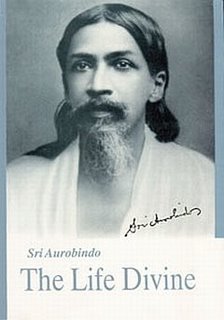 |
The Divine Soul
'Self-Form' of Transcendent
The experiential seeking of the soul has been a time-honoured spiritual pursuit that exalts and uplifts the individual. With the help of this experience and with the simultaneous exceeding of the ego, the individual consciousness can extend to the universal or cosmic consciousness. The individual then understands oneself as a part of the universal consciousness as if the individual consciousness is an eddy or formation in the bosom of the cosmic consciousness. This extension from the individual to the cosmic consciousness does not automatically ensue on having a contact with one's soul, it has to be worked upon but the soul-experience is the starting point.
Sri Aurobindo describes that Reality is simultaneously expressed in the Individual, Universal and Transcendental poises but this simultaneous realisation is not possible in our ordinary cognitive matrix; it can only be experientially perceived in the Supramental Consciousness. It follows therefore a soul-experience in the depths of one’s being cannot identify the Individual with the Universal and Transcendent though it gives an unalloyed joy, peace, serenity and pure but intense love and makes life worth living. With an exceeding of one’s ego, the soul-experience can support the inner being poised behind the surface personality and then through the inner being, one can connect with the universal consciousness. |
|
However a contact with the Transcendent is still difficult unless of course one considers the Transcendent to be extra-cosmic as in the Semitic traditions and hence to be experienced in some heaven in some after-life. The Indian tradition did not consider the Transcendent to be extra-cosmic but supra-cosmic with the cosmos being its representation. To cognize that, the Transcendent had to be experienced through the Spirit (the Jivatman) that supports the manifestation from above, the individual soul being a representative of the Spirit poised within the manifestation. Such an experience of the Transcendent was so overwhelming that everything else in life, even the individual soul and the universal consciousness became insignificant. The Transcendent, the Absolute alone was perceived to represent the Truth.
Sri Aurobindo explains that to have the simultaneous experience of the Individual, Universal and Transcendent, one needs a soul-poise in the Supramental cognitive matrix. This is the Divine Soul. In the Supramental Consciousness, the Divine Soul considers itself not only as a representative of the Transcendent but identifies with the Transcendent as its “self-form” (The Life Divine, pg 165). The individual soul is not merely a representative or portion of the Absolute Transcendent but its self-replication; it is the Absolute itself in a different poise. ‘In every state or act of knowledge it would be aware of the Unknowable cognizing itself by a form of variable self-knowledge; in its every state or act of power, will or force aware of the Transcendence possessing itself by a form of conscious power of being and knowledge; in its every state or act of delight, joy or love aware of the Transcendence embracing itself by a form of conscious self-enjoyment’ (Ibid, pg 165). This is a fundamental experience as it ensures and guarantees the constant presence of the Absolute. ‘This presence of the Absolute would not be with it as an experience occasionally glimpsed or finally arrived at and held with difficulty or as an addition, acquisition or culmination superimposed on its ordinary state of being; it would be the very foundation of its being both in the unity and the differentiation; it would be present to it in all its knowing, willing, doing, enjoying; it would be absent neither from its timeless self nor from any moment of Time, neither from its spaceless being nor from any determination of its extended existence, neither from its unconditioned purity beyond all cause and circumstance nor from any relation of circumstance, condition and causality. This constant presence of the Absolute would be the basis of its infinite freedom and delight, ensure its security in the play and essence of its divine being’ (Ibid, pg 165-166).
'The Absolute, the Perfect, the Alone
Has entered with his silence space:
He has fashioned these countless persons of one self;
He has built a million figures of his power;
He lives in all, who lives in his Vast alone;
Space is himself and Time is only he...'
Sri Aurobindo, Savitri, pg 67
Date of Update:
24-Mar-16
- By Dr. Soumitra Basu
|

